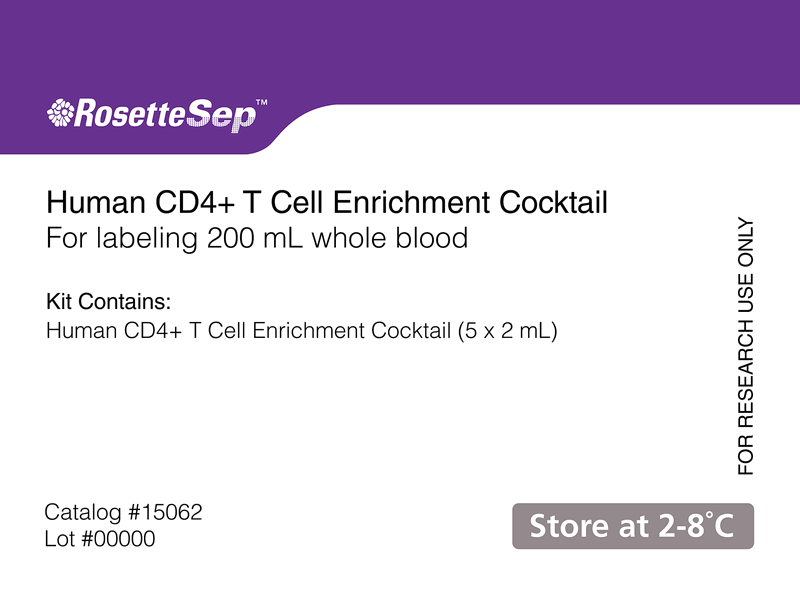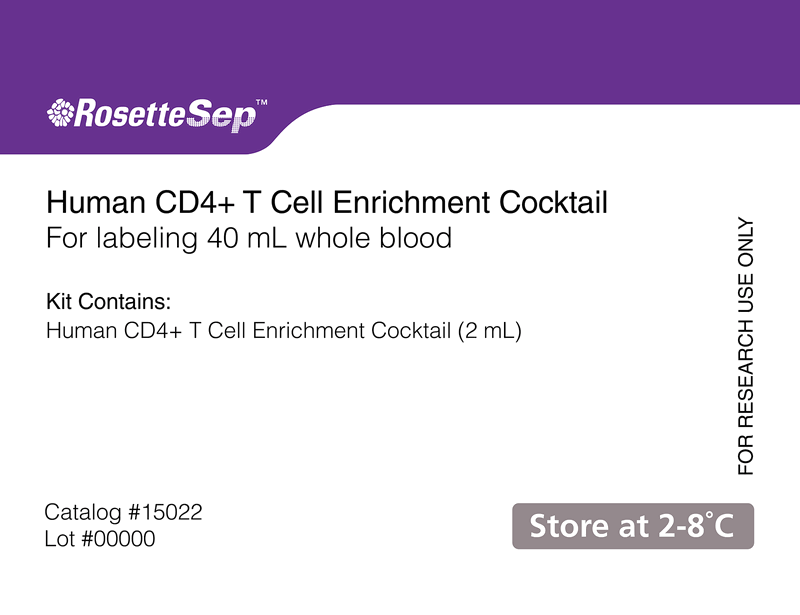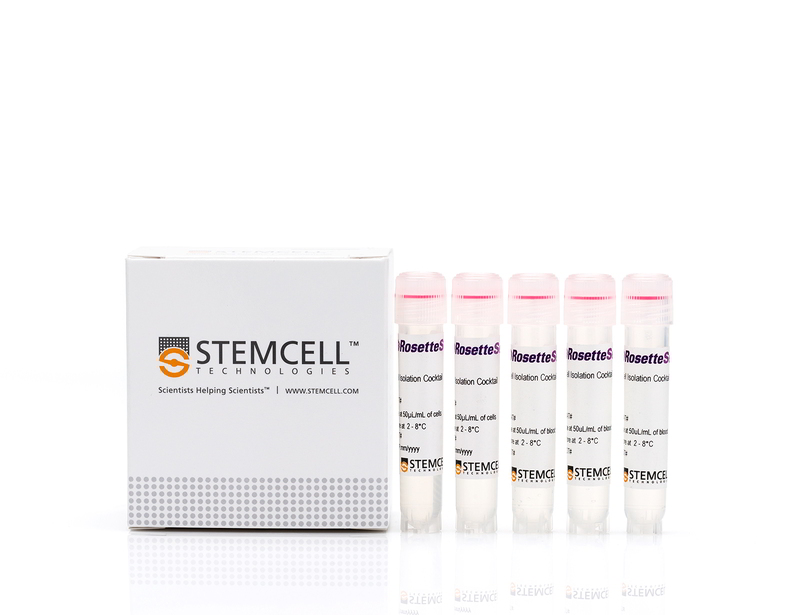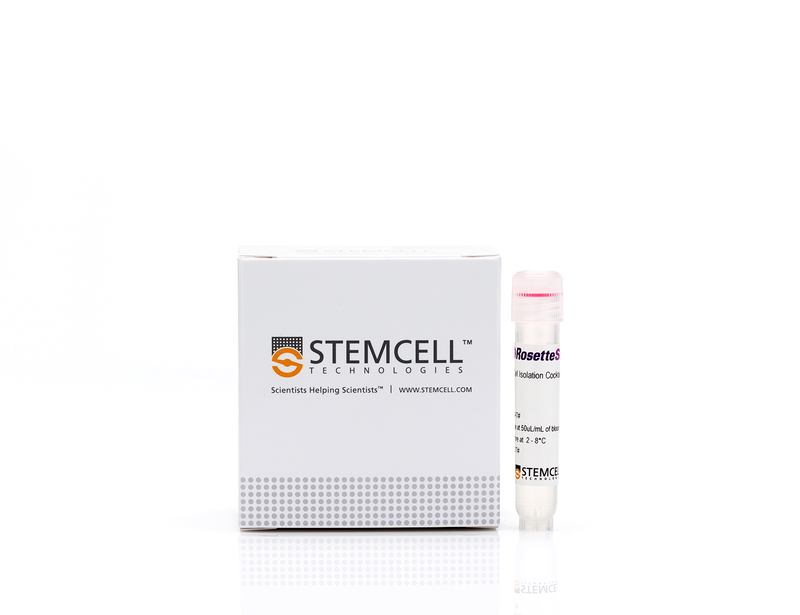RosetteSep™ Human CD4+ T Cell Enrichment Cocktail
Immunodensity negative selection cocktail
概要
The RosetteSep™ Human CD4+ T Cell Enrichment Cocktail is designed to isolate CD4+ T cells from whole blood by negative selection. Unwanted cells are targeted for removal with Tetrameric Antibody Complexes recognizing non-CD4+ T cells and glycophorin A on red blood cells (RBCs). When centrifuged over a buoyant density medium such as RosetteSep™ DM-L (Catalog #15705) or Lymphoprep™ (Catalog #07801), the unwanted cells pellet along with the RBCs. The purified CD4+ T cells are present as a highly enriched population at the interface between the plasma and the buoyant density medium.
Advantages
• Fast and easy-to-use
• Requires no special equipment or training
• Isolated cells are untouched
• Can be combined with SepMate™ for consistent, high-throughput sample processing
• Requires no special equipment or training
• Isolated cells are untouched
• Can be combined with SepMate™ for consistent, high-throughput sample processing
Components
- RosetteSep™ Human CD4+ T Cell Enrichment Cocktail (Catalog #15022)
- RosetteSep™ Human CD4+ T Cell Enrichment Cocktail, 2 mL
- RosetteSep™ Human CD4+ T Cell Enrichment Cocktail (Catalog #15062)
- RosetteSep™ Human CD4+ T Cell Enrichment Cocktail, 5 x 2 mL
Subtype
Cell Isolation Kits
Cell Type
T Cells, T Cells, CD4+
Species
Human
Sample Source
Buffy Coat, Whole Blood
Selection Method
Negative
Application
Cell Isolation
Brand
RosetteSep
Area of Interest
Cell Therapy, Immunology
技术资料
| Document Type | 产品名称 | Catalog # | Lot # | 语言 |
|---|---|---|---|---|
| Product Information Sheet | RosetteSep™ Human CD4+ T Cell Enrichment Cocktail | 15022, 15062 | All | English |
| Safety Data Sheet | RosetteSep™ Human CD4+ T Cell Enrichment Cocktail | 15022 | All | English |
数据及文献
Data
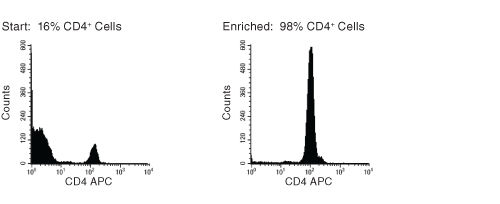
Figure 1. FACS Histogram Results Using RosetteSep™ Human CD4+ T Cell Enrichment Cocktail
Starting with fresh peripheral blood, the CD4+ cell content of the enriched fraction is typically 94 ± 5%.
Publications (59)
Nature microbiology 2020 oct
Vpu modulates DNA repair to suppress innate sensing and hyper-integration of HIV-1.
Abstract
Abstract
To avoid innate sensing and immune control, human immunodeficiency virus type 1 (HIV-1) has to prevent the accumulation of viral complementary DNA species. Here, we show that the late HIV-1 accessory protein Vpu hijacks DNA repair mechanisms to promote degradation of nuclear viral cDNA in cells that are already productively infected. Vpu achieves this by interacting with RanBP2-RanGAP1*SUMO1-Ubc9 SUMO E3-ligase complexes at the nuclear pore to reprogramme promyelocytic leukaemia protein nuclear bodies and reduce SUMOylation of Bloom syndrome protein, unleashing end degradation of viral cDNA. Concomitantly, Vpu inhibits RAD52-mediated homologous repair of viral cDNA, preventing the generation of dead-end circular forms of single copies of the long terminal repeat and permitting sustained nucleolytic attack. Our results identify Vpu as a key modulator of the DNA repair machinery. We show that Bloom syndrome protein eliminates nuclear HIV-1 cDNA and thereby suppresses immune sensing and proviral hyper-integration. Therapeutic targeting of DNA repair may facilitate the induction of antiviral immunity and suppress proviral integration replenishing latent HIV reservoirs.
Scientific Reports 2020 jan
Potent inhibition of HIV replication in primary human cells by novel synthetic polyketides inspired by Aureothin
Abstract
Abstract
Overcoming the global health threat of HIV infection requires continuous pipelines of novel drug candidates. We identified the $\gamma$-pyrone polyketides Aureothin/Neoaureothin as potent hits by anti-HIV screening of an extensive natural compound collection. Total synthesis of a structurally diverse group of Aureothin-derivatives successfully identified a lead compound ({\#}7) superior to Aureothin that combines strong anti-HIV activity (IC90{\textless}45 nM), photostability and improved cell safety. Compound {\#}7 inhibited de novo virus production from integrated proviruses by blocking the accumulation of HIV RNAs that encode the structural components of virions and include viral genomic RNAs. Thus, the mode-of-action displayed by compound {\#}7 is different from those of all current clinical drugs. Proteomic analysis indicated that compound {\#}7 does not affect global protein expression in primary blood cells and may modulate cellular pathways linked to HIV infection. Compound {\#}7 inhibited multiple HIV genotypes, including HIV-type 1 and 2 and synergistically inhibited HIV in combination with clinical reverse transcriptase and integrase inhibitors. We conclude that compound {\#}7 represents a promising new class of HIV inhibitors that will facilitate the identification of new virus-host interactions exploitable for antiviral attack and holds promise for further drug development.
Cell reports 2020 feb
Nef-Mediated CD3-TCR Downmodulation Dampens Acute Inflammation and Promotes SIV Immune Evasion.
Abstract
Abstract
The inability of Nef to downmodulate the CD3-T cell receptor (TCR) complex distinguishes HIV-1 from other primate lentiviruses and may contribute to its high virulence. However, the role of this Nef function in virus-mediated immune activation and pathogenicity remains speculative. Here, we selectively disrupted this Nef activity in SIVmac239 and analyzed the consequences for the virological, immunological, and clinical outcome of infection in rhesus macaques. The inability to downmodulate CD3-TCR does not impair viral replication during acute infection but is associated with increased immune activation and antiviral gene expression. Subsequent early reversion in three of six animals suggests strong selective pressure for this Nef function and is associated with high viral loads and progression to simian AIDS. In the absence of reversions, however, viral replication and the clinical course of infection are attenuated. Thus, Nef-mediated downmodulation of CD3 dampens the inflammatory response to simian immunodeficiency virus (SIV) infection and seems critical for efficient viral immune evasion.
Science advances 2020 aug
Gliotoxin, identified from a screen of fungal metabolites, disrupts 7SK snRNP, releases P-TEFb, and reverses HIV-1 latency.
Abstract
Abstract
A leading pharmacological strategy toward HIV cure requires shock" or activation of HIV gene expression in latently infected cells with latency reversal agents (LRAs) followed by their subsequent clearance. In a screen for novel LRAs we used fungal secondary metabolites as a source of bioactive molecules. Using orthogonal mass spectrometry (MS) coupled to latency reversal bioassays we identified gliotoxin (GTX) as a novel LRA. GTX significantly induced HIV-1 gene expression in latent ex vivo infected primary cells and in CD4+ T cells from all aviremic HIV-1+ participants. RNA sequencing identified 7SK RNA the scaffold of the positive transcription elongation factor b (P-TEFb) inhibitory 7SK small nuclear ribonucleoprotein (snRNP) complex to be significantly reduced upon GTX treatment of CD4+ T cells. GTX directly disrupted 7SK snRNP by targeting La-related protein 7 (LARP7) releasing active P-TEFb which phosphorylated RNA polymerase II (Pol II) C-terminal domain (CTD) inducing HIV transcription."
Science signaling 2019 apr
Cooperation between T cell receptor and Toll-like receptor 5 signaling for CD4+ T cell activation.
Abstract
Abstract
CD4+ T cells recognize antigens through their T cell receptors (TCRs); however, additional signals involving costimulatory receptors, for example, CD28, are required for proper T cell activation. Alternative costimulatory receptors have been proposed, including members of the Toll-like receptor (TLR) family, such as TLR5 and TLR2. To understand the molecular mechanism underlying a potential costimulatory role for TLR5, we generated detailed molecular maps and logical models for the TCR and TLR5 signaling pathways and a merged model for cross-interactions between the two pathways. Furthermore, we validated the resulting model by analyzing how T cells responded to the activation of these pathways alone or in combination, in terms of the activation of the transcriptional regulators CREB, AP-1 (c-Jun), and NF-kappaB (p65). Our merged model accurately predicted the experimental results, showing that the activation of TLR5 can play a similar role to that of CD28 activation with respect to AP-1, CREB, and NF-kappaB activation, thereby providing insights regarding the cross-regulation of these pathways in CD4+ T cells.
Proceedings of the National Academy of Sciences of the United States of America 2017 OCT
Gut microbiota from multiple sclerosis patients enables spontaneous autoimmune encephalomyelitis in mice.
Abstract
Abstract
There is emerging evidence that the commensal microbiota has a role in the pathogenesis of multiple sclerosis (MS), a putative autoimmune disease of the CNS. Here, we compared the gut microbial composition of 34 monozygotic twin pairs discordant for MS. While there were no major differences in the overall microbial profiles, we found a significant increase in some taxa such as Akkermansia in untreated MS twins. Furthermore, most notably, when transplanted to a transgenic mouse model of spontaneous brain autoimmunity, MS twin-derived microbiota induced a significantly higher incidence of autoimmunity than the healthy twin-derived microbiota. The microbial profiles of the colonized mice showed a high intraindividual and remarkable temporal stability with several differences, including Sutterella, an organism shown to induce a protective immunoregulatory profile in vitro. Immune cells from mouse recipients of MS-twin samples produced less IL-10 than immune cells from mice colonized with healthy-twin samples. IL-10 may have a regulatory role in spontaneous CNS autoimmunity, as neutralization of the cytokine in mice colonized with healthy-twin fecal samples increased disease incidence. These findings provide evidence that MS-derived microbiota contain factors that precipitate an MS-like autoimmune disease in a transgenic mouse model. They hence encourage the detailed search for protective and pathogenic microbial components in human MS.

